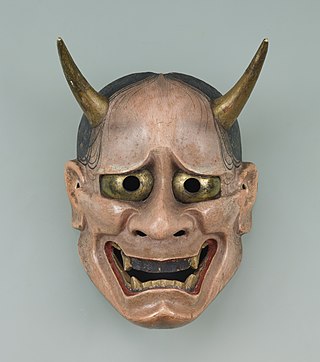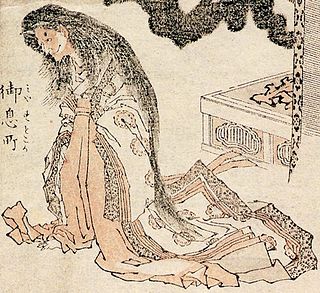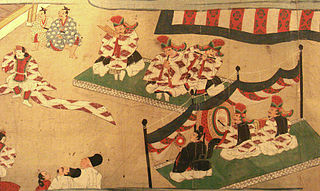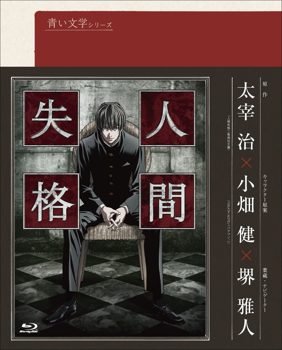
The Tale of Genji, also known as Genji Monogatari is a classic work of Japanese literature written in the early 11th century by the noblewoman, poet, and lady-in-waiting Murasaki Shikibu. The original manuscript, created around the peak of the Heian period, no longer exists. It was made in "concertina" or orihon style: several sheets of paper pasted together and folded alternately in one direction then the other.

Noh is a major form of classical Japanese dance-drama that has been performed since the 14th century. Developed by Kan'ami and his son Zeami, it is the oldest major theater art that is still regularly performed today. Although the terms Noh and nōgaku are sometimes used interchangeably, nōgaku encompasses both Noh and kyōgen. Traditionally, a full nōgaku program included several Noh plays with comedic kyōgen plays in between; an abbreviated program of two Noh plays with one kyōgen piece has become common today. Optionally, the ritual performance Okina may be presented in the very beginning of nōgaku presentation.
Zeami Motokiyo, also called Kanze Motokiyo, was a Japanese aesthetician, actor, and playwright.

Ono no Komachi was a Japanese waka poet, one of the Rokkasen—the six best waka poets of the early Heian period. She was renowned for her unusual beauty, and Komachi is today a synonym for feminine beauty in Japan. She also counts among the Thirty-six Poetry Immortals.
Genji monogatari is an opera by the Japanese composer Minoru Miki, with the libretto by Colin Graham, based on the eponymous early 11th-century masterpiece of classical Japanese literature by Murasaki Shikibu. The opera was composed in 1999 and premiered in June 2000 at Opera Theatre of Saint Louis (OTSL) in the United States, with Graham directing the production. Cast members from the OTSL production participated in the Japanese premiere of the opera on 20 September 2001.
Aoi no Ue (葵の上) is a fictional character in The Tale of Genji. Daughter of the Minister of the Left and Genji's first principal wife, she marries Genji when she is sixteen and he is only twelve. Proud and distant from her husband, Aoi is constantly aware of the age difference between them and very much hurt by Genji's philandering. Aoi temporarily gains Genji's favour after giving birth to his son Yūgiri and experiencing spells of spirit possession. The episode of spirit possession itself is extremely controversial and brings forward two female characters of the tale: Aoi and Lady Rokujō. The relationship between the two women may be that between victim and aggressor, if one follows the traditional interpretation of spirit possession, or that between accomplices expressing their discontent with the Heian system of polygynous marriage. Aoi dies at the end of the "Aoi" chapter and her exit from the tale is thus definitive.

Uemura Shōen was the pseudonym of an artist in Meiji, Taishō and early Shōwa period Japanese painting. Her real name was Uemura Tsune. Shōen was known primarily for her bijin-ga, or paintings of beautiful women, in the nihonga style, although she produced numerous works on historical themes and traditional subjects. Shōen is considered a major innovator in the bijin-ga genre despite the fact she often still used it to depict the traditional beauty standards of women. Bijin-ga gained criticism during the Taisho era while Shōen worked due to its lack of evolution to reflect the more modern statuses of women in Japan. During bijin-ga's conception in the Tokugawa, or Edo, period, women were regarded as lower class citizens and the genre often reflected this implication onto its female subjects. Within the Taisho era, women had made several advancements into the Japanese workforce, and artistry specifically was becoming more popular outside of pass times for the elite, which opened way for Shōen's success. Shōen received many awards and forms of recognition during her lifetime within Japan, being the first female recipient of the Order of Culture award, as well as being hired as the Imperial Household's official artist, which had previously only employed one other official woman in the position. In 1949 she died of cancer just a year after receiving the Order of Culture Award.

Bahrām Beyzāêi is an Iranian playwright, theatre director, screenwriter, film editor, and ostād ("master") of Persian letters, arts and Iranian studies.

The hannya (般若) is a mask used in Japanese Noh theater, representing a jealous female demon. It is characterized by two sharp bull-like horns, metallic eyes, and a leering mouth. In Noh plays, the type of mask changes according to the degree of jealousy, resentment, and anger of the female characters. The hannya is a mask that represents a female onryō even more resentful, jealous, and angry than the namanari (生成), a woman on the verge of becoming a demoness.

Lady Rokujō is a fictional character in The Tale of Genji. She is a mistress of the novel's protagonist, Hikaru Genji, with whom she becomes infatuated with and jealous of his other lovers. Her jealousy subconsciously causes her ikiryō to become a Shiryo that attacks and murders multiple other mistresses and wives of Genji.

Aoi no Ue is a Muromachi period Japanese Noh play based on the character Lady Aoi from the Heian period novel The Tale of Genji. It is an example of the fourth category of "miscellaneous" Noh plays. Aoi no Ue was the first of many Noh plays based on The Tale of Genji. It is sometimes attributed to Zeami Motokiyo or to his son-in-law Zenchiku; the extant version of the text is likely a reworking of a version written for the troupe of a contemporary, Inuō.

Traditional Japanese music is the folk or traditional music of Japan. Japan's Ministry of Education classifies hōgaku as a category separate from other traditional forms of music, such as gagaku or shōmyō, but most ethnomusicologists view hōgaku, in a broad sense, as the form from which the others were derived. Outside of ethnomusicology, however, hōgaku usually refers to Japanese music from around the 17th to the mid-19th century. Within this framework, there are three types of traditional music in Japan: theatrical, court music, and instrumental.
Konparu Zenchiku was a skilled Japanese Noh actor, troupe leader, and playwright. His plays are particularly characterized by an intricate, allusive, and subtle style inherited from Zeami Motokiyo which convolved yūgen with influences from Zen Buddhism and Kegon. Actors should strive for unconscious performance, in which they enters the "circle of emptiness"; such a state of being is the highest level of artistic or religious achievement.

Aoi Bungaku Series is a twelve episode Japanese anime series featuring adaptations inspired by six short stories from Japanese literature. The six stories are adapted from classic Japanese tales. Happinet, Hakuhodo DY Media Partners, McRAY, MTI, Threelight Holdings, Movic, and Visionare were involved in the production of the series. Character designs were provided by manga artists Takeshi Obata, Tite Kubo and Takeshi Konomi (#9–10).The stories adapted here may stray away significantly from the original plot of the classics, even if they try to capture the essence of the stories.There are some titbits told by the host Sakai Masato about the background of the story before the animation starts.

Ako, or Ako Dachs, is a Japanese actress and founding Artistic Director of Amaterasu Za theatre company. She received a Lucille Lortel Award nomination for Outstanding Lead Actress in 2019.
Five Modern Noh Plays is a collection of plays written by Japanese writer Yukio Mishima. Mishima wrote these plays between 1950 and 1955 and presented them as modern plays in Tokyo. Of these five, only The Damask Drum was expressed in the traditional Noh fashion. The Lady Aoi was expressed as a Western-style opera. The plays take older Nō plots or traditional and foreign fairy tales and bring them to a modern setting.
Sotoba Komachi (卒塔婆小町) is one of the stories in Five Modern Noh Plays by Yukio Mishima. The original work was written by Kanami and was later reworked by Mishima Yukio for modern theatre. The kanji 卒塔婆 means stupa and小町 is the synonym of belle or beautiful woman. The story was written in 1952 and published in 1956. It was translated by Japanese literature expert Donald Keene into English in 1957. Sotoba Komachi is the third story of The Five Modern Noh Plays.
The Lady Aoi was a 1998 production of Yukio Mishima's play of the same name in Persian translation, which was produced and directed by Bahram Beyzai in his as yet only production of a play by a playwright other than himself.
Rie Yoshiyuki was a Japanese writer of short stories, novels and poetry. She was awarded the Noma Children's Literature Newcomer Award, the Akutagawa Prize, and the Women's Literature Prize.











